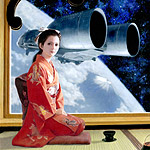

About Nippon 2007
About WorldCons
Agents
Art Show
Awards
Blogs/Galleries
Checklist
Child Care
Committee
Contact Us
Con Suite
Contests
Dealers Room
Donbura-con
Exhibits
Facilities / Maps
F A Q
Fanspeak
Filking (Music!)
Guests of Honor
Handicapped Services
Hotels
Hotel Alternatives
Hugo Awards
Hugo Winners
Hugo Nominees
Rocket Archive
Language/Food/Culture
Links
LiveJournal
Main Events:
Masquerade
Members
Mmbrshp Transfer
Newsletters (At Con)
Parties
Photos
Program - Western
Program Grid
Program Participants
Program - Japanese
Publications
Registration
Seals/Stickers
Seiun Awards
Site Map
Site Selection 2009
Speculative Japan
Tour with Fans
Ghibli Tour
Travel
Travel Links
Volunteers
World S F Society
Nippon Bid Site
Nippon2007.org
Archon 31 (NASFiC)
2008 Denvention 3
2009 Anticipation
![]()
![]()
Fighting Jet Lag in Narita
For most of us westerners, the journey to Japan will be the longest airplane flight of our lives, and our first encounter with serious jet lag.
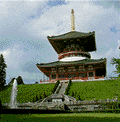 Airline crews are the most seasoned travellers around, and they'll arrange the flight to help you adjust to Japan time. The basic plot is to feed you, then put you to bed with a full tummy. Even though the sun is still shining, you'll be asked to close the window shades. You may not feel sleepy, but some soft, spongy earplugs and a boring non-SF&F novel are great sleep aids. In-flight movies are good, too, if you start out with the least interesting and keep the volume down. Sometimes the headset audio channels have good sleepy-time tunes.
Airline crews are the most seasoned travellers around, and they'll arrange the flight to help you adjust to Japan time. The basic plot is to feed you, then put you to bed with a full tummy. Even though the sun is still shining, you'll be asked to close the window shades. You may not feel sleepy, but some soft, spongy earplugs and a boring non-SF&F novel are great sleep aids. In-flight movies are good, too, if you start out with the least interesting and keep the volume down. Sometimes the headset audio channels have good sleepy-time tunes.
The trip is so long, however, that somewhere mid-ocean the lights will come back up and the crew will start another meal service. Hungry or not, go with it. This is all part of time-zonification. After dinner might be a good time to catch the best of the movie choices.
All good things must end, and so you arrive in Narita, Japan's gateway city. If you're lucky, you'll be ready to grab your bags and catch the Narita Express to Yokohama. If you're typical, you won't, especially if you've come from Europe. Eastbound flights always produce the worst jet lag, so North American members will get extra lagged on the way home.
If you can come a day early, a good option is to spend your first night in Narita. The Narita hotels are geared up for western tourists, providing free bus service to and from the airport, and usually free buses downtown.
Narita has 100,000 residents, shopping malls, and everything you'd expect of a town that size.
 The featured attraction, however, is Naritasan Shinshoji Temple, a Buddhist temple complex that was begun there over a thousand years ago, and its associated "Temple Town," kind of an Old Town Narita.
The featured attraction, however, is Naritasan Shinshoji Temple, a Buddhist temple complex that was begun there over a thousand years ago, and its associated "Temple Town," kind of an Old Town Narita.
After you check in at your Narita hotel, grab your camera and take the hotel bus downtown to the drop off point, a bus/taxi plaza. If you're just in a temple mood, you can take a taxi, but it's more interesting to take the outdoor (yes!) escalator up the hill and under the Keisei Line train station to the Temple Town bus plaza.
(The ¥200 Pink bus goes to Aeon Shopping Center, a Japanese version shopping mall.)
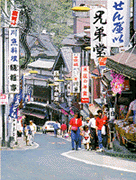 Keep in mind that many westerners you see in town will be airline crew. They know their way around and will be happy to direct you.
Keep in mind that many westerners you see in town will be airline crew. They know their way around and will be happy to direct you.
Cross the plaza to the bus shelter and turn right, the direction most of the buses and tourists take, and you're on the main street. After a block, it's one lane and you're sharing it with cars and buses. You'll find restaurants and shops of every description on this winding road (that was a Brazilian restaurant you passed just before McDonald's).
The road angles, then curls down the hill to Naritasan.
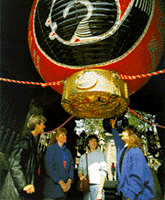 "San" in this case means "mountain," and the temple complex climbs up the hill and runs along the ridge.
As you enter, you pass vendors' stalls on the way to Niomon Gate and its huge red lantern.
"San" in this case means "mountain," and the temple complex climbs up the hill and runs along the ridge.
As you enter, you pass vendors' stalls on the way to Niomon Gate and its huge red lantern.
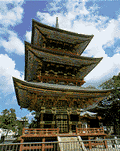 Climb the steps to reach the Sacred Walking Enclosure, with its three temples and beautiful three-tiered pagoda.
Far to the left is a Shinto assembly hall, looking for all the world like a convention center.
Climb the steps to reach the Sacred Walking Enclosure, with its three temples and beautiful three-tiered pagoda.
Far to the left is a Shinto assembly hall, looking for all the world like a convention center.
Paths on either side of the main temple lead up the hill. The left goes past a village of temples and shrines, ending eventually at the great Daito Pagoda, whose top tower can be seen from all over the city. The rightward path runs up through Naritasan Park, best described as a Japanese version of Nature. It is truly movie-set beautiful as you walk the trails and take little bridges over babbling brooks. The paths wind down to a pond and flowerful square below the Daito Pagoda, where you can complete the circuit past all the little temples.
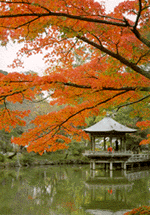
 You should have run out of film or batteries by now, so head out the entrance and back up the hill to one of those restaurants you passed on the way down. The prices are very reasonable, and the experience will be memorable.
You should have run out of film or batteries by now, so head out the entrance and back up the hill to one of those restaurants you passed on the way down. The prices are very reasonable, and the experience will be memorable.
The hotel buses pick up from the drop off plaza two or three times and hour, and most hotels will have a printed timetable, and one posted at the plaza. You should be tired and the sun sinking by the time you get back to your room, so hit the hay and wake up acclimatized and ready to catch the hotel bus back to the airport, and your train/bus to Yokohama.
All photos ©Narita City